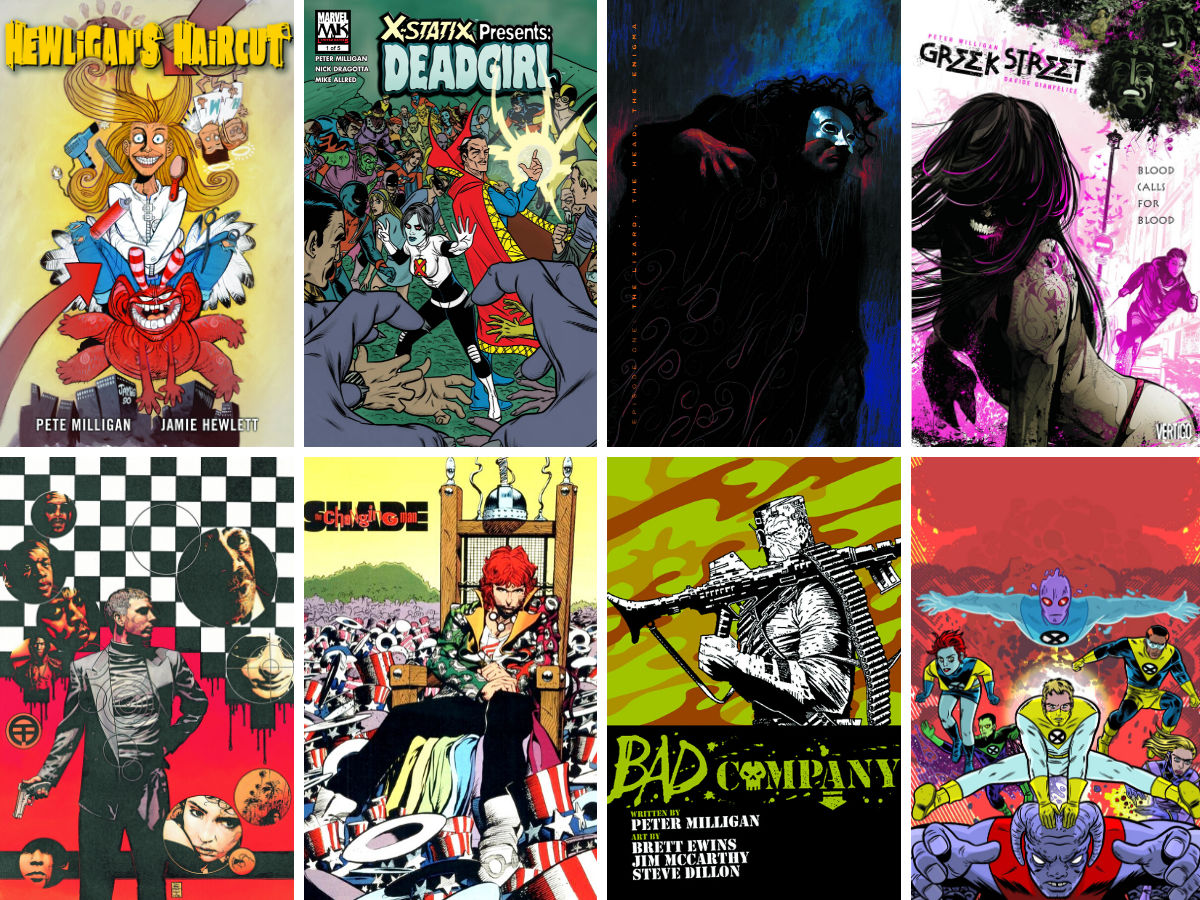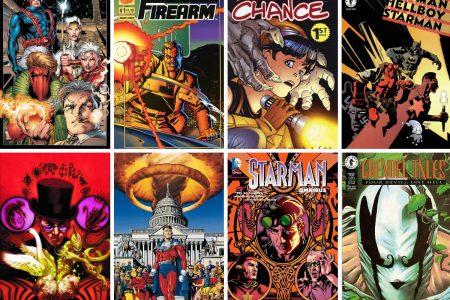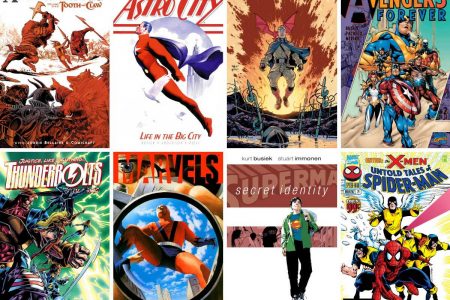Continuing with the theme of my favourite works by a writer I enjoy: today is the turn of Peter Milligan. The man, the mystery, the enigma (deliberate reference – see later); Milligan is an unusual writer who revels in his unusualness and intelligence and literary passions. His website is called Ineluctable Modality, which comes from a quote from Ulysses by James Joyce, meaning approximately ‘A particular form of sensory perception or mode in which something is experienced or expressed that is inescapable or unable to be avoided’. If that doesn’t give you a sense of who Milligan is and what is writing is about, then you need to read some of the stories mentioned here.
Milligan first came to prominence, like many British comic book writers, at 2000 AD – in the mid-1980s, he started to write Time Twisters (the traditional route for new writers) but soon found acclaim with his first ongoing strip, Bad Company, a sci-fi-set war comic with art by the late Brett Ewins; this led to other strips, such as Hewligan’s Haircut with Jamie Hewlett, and Bix Barton with Jim McCarthy, but he also wrote his first work for DC in 1989 – Skreemer, a six-issue mini-series with art by Ewins that was a mix of gangster films and Finnegan’s Wake. Despite not doing as well as it deserved, Milligan was given more work at DC, as well as continuing to work in the UK in 2000 AD, Revolver (the Rogan Gosh strip, later collected by DC) and Deadline (the Johnny Nemo strip).
His DC work included writing some Batman stories and a short run on Animal Man after Grant Morrison’s acclaimed run, but it was his reinvention of Shade, The Changing Man that would put Milligan in the firmament of British comic book writers who rose to fame in the 1990s. It was completely different from Steve Ditko’s original version and stood out for its weirdness, maturity, adult themes and singular voice. Perhaps due to this success, a publisher was found for Skin, the story of a young thalidomide skinhead in 1970s London, with art by long-time collaborator Brendan MacCarthy, a powerful and disturbing book that was to feature in Crisis but the publishers were afraid to print.
Shade, The Changing Man would become one of the books that started the Vertigo imprint at DC, and it is arguable that Milligan’s best work was done for Vertigo. Enigma, the eight-issue series with art by Duncan Fegredo, is a marvellous book about identity and sexuality; there was also The Extremist (art by Ted McKeever), Face (with Fegredo), Egypt (with Glyn Dillon), Girl (with Fegredo), The Eaters (with Dean Ormiston), The Minx (with Sean Phillips), The Human Target, and Vertigo Pop London (with Philip Bond).
However, during this time, he also wrote for Marvel: an X-Men mini-series (The Further Adventures of Cyclops and Jean Grey) and, even more bizarrely, launching an ongoing series for Elektra, with art by Mike Deodato Jr. This would lead to his best work at Marvel, taking over X-Force with issue 116 in 2001 and, with art by Mike Allred, completely changing the team and the concept to that of a satire of modern celebrity, eventually becoming X-Statix a year later. He would go on to write various mini-series there, including a Wolverine/Punisher story and a Dead Girl/Doctor Strange mini-series, as well as a three-year run on X-Men, before recommencing work with DC at the same time. He has mostly stayed there, doing various things (The Programme, Infinity Inc.) in addition to various Marvel mini-series (5 Ronin), with only Greek Street and a long and well-received run on Hellblazer sticking out in his resume. Recently, he was part of the DC Nu52 reboot, launching Justice League Dark (featuring the rebooted versions of Shade and John Constantine) and Red Lanterns, and subsequently taking over Stormwatch; in addition, he’s been working with Valiant on some of their titles (Shadowman, Eternal Warrior, Bloodshot), as well as a Doop mini-series at Marvel, keeping all his options open but keeping in the superhero camp instead of the interesting, absurdist, literary work for which he is known. This is the edited highlights – he has written many, many more comic books of different characters for different companies – so trying to pin down Milligan is hard, something I think he enjoys.
My five favourite Milligan works:
5. Hewligan’s Haircut
Hewligan cuts his hair because he is leaving a lunatic asylum, only for it to form an impossible hole in the middle that you can see from any angle. And so begins a surreal odyssey in which Milligan and Hewlett (before Tank Girl and Gorillaz) show off, have fun, and enjoy themselves in an entertaining fashion. It shows that Milligan has a sense of humour and that you can mix the silly with the literary in a comic book with great results.
4. X-Statix Presents: Dead Girl
It has Dead Girl in the title, but it’s basically a team-up with Doctor Strange, and Milligan is the perfect writer for Doctor Strange, so this was probably the only way he could get his hands on the character. A villain is bringing back Marvel characters from the dead so he can be revived himself, and only Doctor Strange and Dead Girl can stop him, in a lively (pardon the pun) story with nice pop art from Nick Dragotta.
3. Bad Company
This story was where I first discovered Milligan, back in 1986 in the pages of 2000 AD, so it will always have a place in my heart. A future war story on the planet Ararat where humanity fights the alien Krool, it is about Danny Franks, a new soldier, who is saved by the misfit Bad Company led by Kano, and then joins them in their fight against the Krool, if he can survive … The story was about the craziness of war with a literary bent (Danny keeps a diary) and the violence and its effects on the people who fight them. A really great 2000 AD story.
2. Enigma
A marvellous examination of sex, love, death, superheroes, and lizards, with beautiful expressive art from Fegredo and powerful writing from Milligan in a story about Michael Smith, an ordinary bloke who has forgotten about his imaginary childhood friend, the Enigma, who used to have his own comic books, until a serial killer strikes near to home and Michael investigates, only to find the Enigma in the real world. The reality and character of this book linger long after reading, and it’s a moving story of two people finding each other. A great series from the Vertigo heyday.
1. Shade, The Changing Man
Was there ever a better distillation of Milligan than in the pages of Shade, The Changing Man? Admittedly, he had more time to explore interests in an ongoing series, but it’s a book that grips you from the start: Shade, a ‘madness agent’ from the planet Meta, has taken over the body of the psychopath at the moment of his execution in order to stop the American Scream, and has to use the help of Kathy George, the woman who lost her parents and boyfriend to the killer, to do it. And then it gets really weird … The plots aren’t the main thing about this book, and Milligan was more interested in the madness and the characters, and he had Chris Bachalo developing into a talented comic book artist to help him. There is some argument that it should have stopped at issue 50 instead of 75, but it was always interesting and different, and that’s something that’s hard to achieve.




